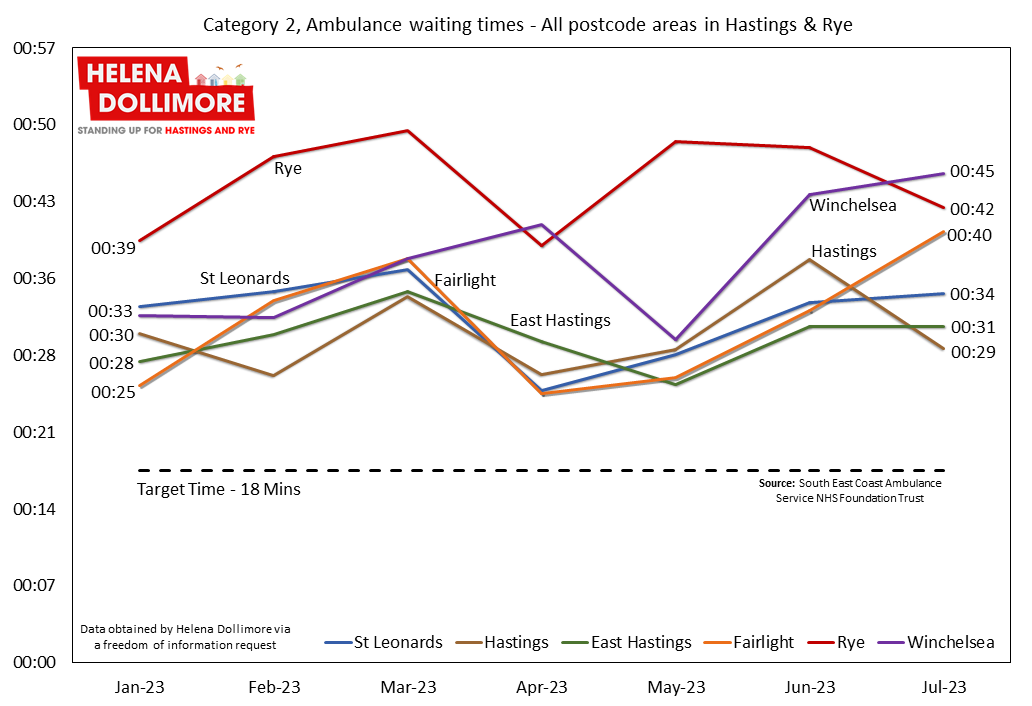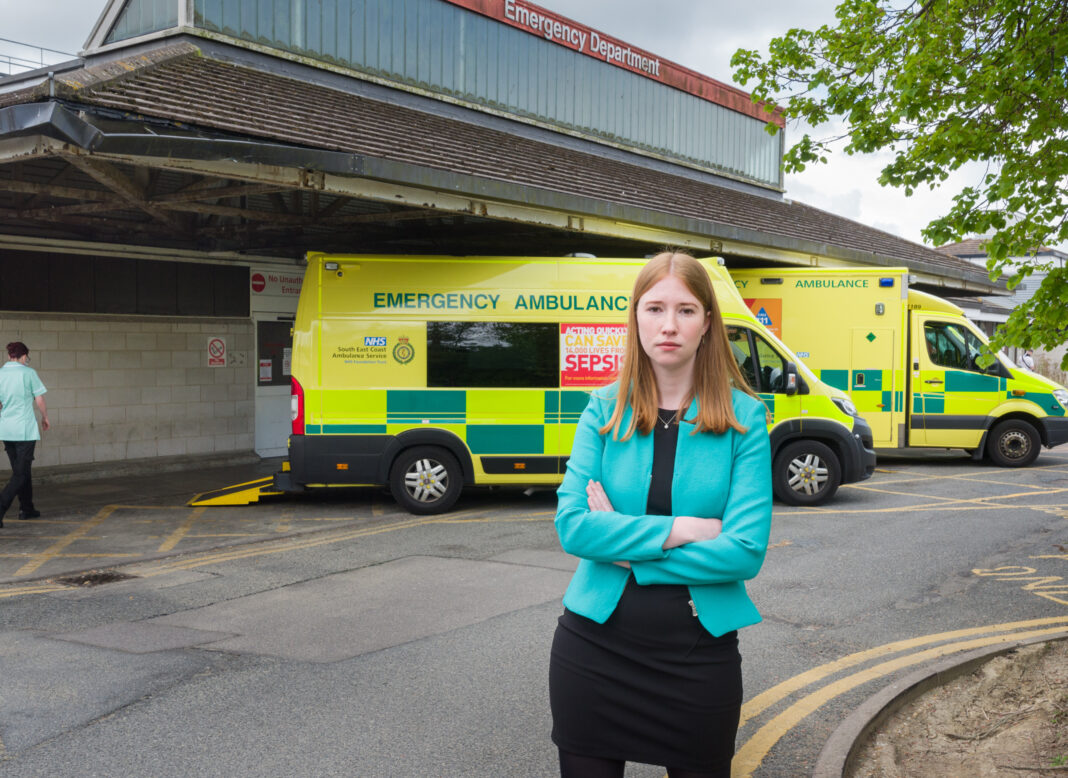As the NHS turns 75, how do we rescue it from the biggest crisis in its history?
This summer my dad turned 75, and he hates people drawing attention to it! But as he was one of the first babies born under the NHS, his birthday has coincided with the celebrations to mark the 75th anniversary of our great National Health Service. Unlike my dad, as the NHS turns 75, it has never been in a worse state.
Too often, the NHS isn’t there for people when they need it. Ambulances don’t always reach people in time to save lives, and people face long waits accessing GP appointments and operations.
Data I’ve obtained shows how people in Hastings and Rye are waiting much longer for an ambulance than many areas in Sussex and Kent. The issue is particularly severe for residents in Rye and surrounding villages. For suspected strokes and heart attacks, ambulances are meant to reach people within 18 minutes. But as the data I have obtained under freedom of information request shows in the first half of this year residents in Rye are often waiting over twice that.

The latest waiting lists published by our local East Sussex NHS trust show how long people wait for treatment locally. NHS targets, introduced and met under the last Labour Government, dictate that 95% of patients should be treated in under 18 weeks. But in East Sussex, 50% of patients wait longer than 18 weeks. Almost 17,000 children in Sussex are stuck on mental health waiting lists (Dec 2022) and this is why your local Rye Labour Councillor Simon McGurk recently raised this at the East Sussex Health panel. 422 women in East Sussex have been waiting longer than a year for gynaecology treatment. The figures mask the human reality of these waits but behind the numbers are people waiting in pain, putting plans on hold, unable to work and enjoy their life to the full.
The impact is also felt in our economy and our public services. Only this week I heard about a key local service whose ability to operate safely is being undermined by the number of staff on sick leave stuck on long NHS waiting lists.
Faced with such a crisis, we have a Conservative Government who blame everyone but themselves for this mess. They blamed the pandemic, even though waiting lists were going up long before it. Then they blamed NHS staff for going on strike, while refusing to sit down and negotiate. It is our brilliant NHS paramedics, nurses and doctors who work their socks off and are then placed in impossible situations unable to deliver the quality of care they were trained to deliver.

And we’ve even had recent Conservative Health Secretaries Sajid Javid and Matt Hancock propose charging for GP appointments and entry to A&E. It is particularly egregious to hear the architects of the crisis in the NHS, having run it down for thirteen years, to now say it is ‘unsustainable’. I couldn’t disagree more and I’ll never accept the pessimism of the Conservatives. Labour, the party that created the NHS, will never abandon a publicly funded NHS free at the point of need. Things can and will get better under Labour by combining investment and reform.
By abolishing the non-dom tax break, we will deliver the biggest increase in doctors, nurses and midwives ever seen to cut waiting lists and treat people on time. And this will save money too, as I found the Conquest Hospital spent over £5 million on agency nurses and doctors last year to fill staff vacancies. If people could see a GP at the first sign of illness, they would be less likely to end up in A&E. Too much of the NHS budget has to be spent in our hospitals because we don’t focus enough on prevention, early intervention and social care. As a result, 4.5 million patients every year end up in A&E because they can’t get a GP appointment. And too many reach a crisis point because they can’t get mental health support or take up a hospital bed there is no social care available.
Building capacity and training more NHS staff takes time, so in the meantime we would use every lever at our disposal to cut waiting lists. This includes using spare capacity that currently exists in the private sector to bring down waiting lists. This is capacity that the current government hasn’t utilised and if they had, hundreds of thousands more patients would have been treated on the NHS in private hospitals and be off NHS waiting lists, out of pain and back in work.
Labour will reform the NHS, to shift the focus from hospitals to the community and from treatment to prevention. Doubling the number of district nurses qualifying each year will mean more patients treated in the comfort of their own homes. And by putting a mental health specialist in every school we can help more children and reduce the burden on teachers.
And tackling the crisis in our NHS also requires us to reform our social care system. Labour is committed to ensuring better terms and conditions, proper training and fair pay for care workers, with national standards to guarantee good quality care, as the first steps to building a national care service.
The last Labour government delivered the shortest waiting times and the highest patient satisfaction in history. It will be one of the central missions of the next Labour government to rescue the NHS from the biggest crisis in its history, and renew the service so it is still there for us for the next 75 years. Only Labour can build an NHS fit for the future, so it’s there for us when we need it.
Image Credits: Helena Dollimore .




That all sounds marvellous – when can you start?
Joking aside, I think we’d all agree with Ms Dollimore that the NHS in England is on life support, but as Labour know from their stewardship of NHS Wales, where waiting times are even longer than in England, it’s not quite as simple as Sir Keir would have us believe… So, might I offer a second opinion?
No political party can administer an instant cure. And as somebody with one child born under Labour and one under the Coalition I would suggest we needn’t get too misty eyed about the recent past. I recall the Whittington in North London in 2008 had blood spattered on the ceiling, a chicken bone on the floor of the birthing room, and a heart monitor that repeatedly failed at the crucial moment. Really… So things are certainly awful now, but let’s not pretend the patient has not been declining for decades…
As they say in the films, ‘give it to me straight, Doc…’ Sorting out the NHS is a generational challenge. It won’t be miraculously mended in five years of a Labour Govt., and it’s disingenuous to imply otherwise – it’s snake oil.
I don’t want to make this party political, bcs that’s part of the problem, but though Labour like to claim ownership of the NHS, it was conceived by a Liberal, William Beveridge, in 1942, proposed by a Conservative, Henry Willink, in his 1944 White Paper, and implemented by Labour in 1948.
But the point is, the NHS, like many critical services, belongs to us all and needs to serve us all efficiently and effectively… Right now, it doesn’t. The best way to run any strategic service is according to a long term strategic plan, the kind that our present political system simply cannot deliver. The NHS shouldn’t be politicised. You could say the same for education, defence, foreign policy, law, agriculture, energy policy etc etc etc. So, my prescription for the NHS and everything else, would be to first treat the ills of our myopic, media-fixated politics and our ‘divide and rule’ electoral system, and wrench our democracy back to the kind of broad era of consensus that gave rise to the NHS in the first place… That requires electoral reform. Whatever else any political party promises you in the coming year, if they won’t give you a fair electoral system, they’re not offering real change, they’re offering to treat the symptoms, not cure the disease.
Well said Guy, and Helena is right ti draw attention to waiting Times for ambulances.
To ambulances delays we add long distances and slow roads between us and specialist hospitals. In the case of stroke it is necessary to start treatment within (I think) four hours of the event.
The time to call the ambulances, the wait for the ambulance, stabilisation of the patient, the one hour plus journey to Eastbourne, then scans and diagnosis means the target is likely to be missed. The effectivenesss of treatment is then much reduced and death and permanent disability much more likely. Compare that with times and treatment in central London and we have a dreadful and unaceptable discrepancy.